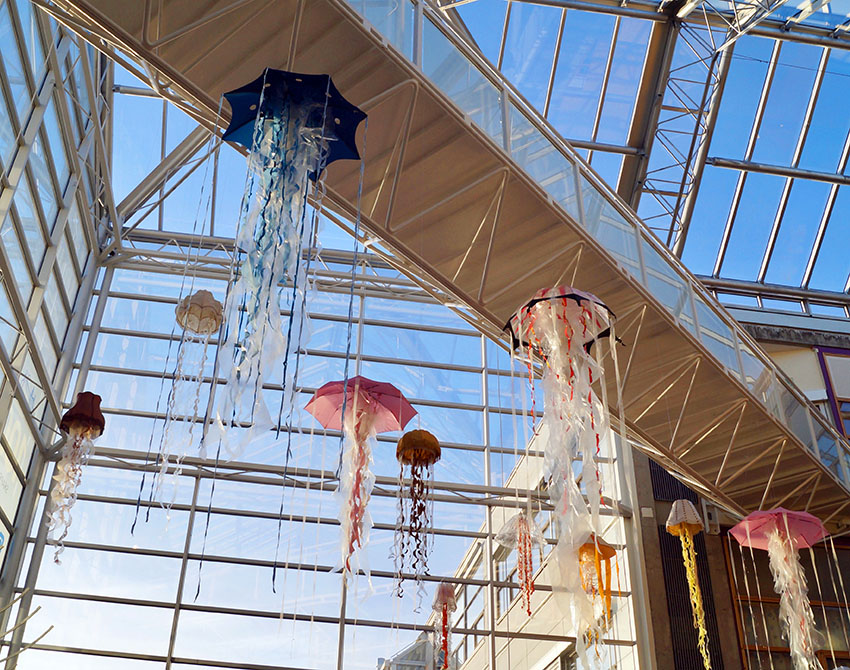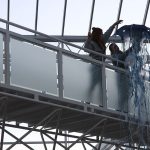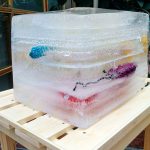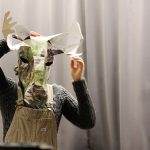An artistic invasion
Imagine that you received an email with an attachment. When you opened it, you suddenly found a virus on your computer. Instead of doing harm, the virus asks: «Are you willing to face environmental issues?”
With every click and answer follows a cascade of information on anthropogenic causes of a strong increase in the jellyfish population and its link to climate change. The virus ends with opening a website that offers easily implemental daily behaviors to decrease your carbon footprint.
Environmental Communications
A group of NTNU students actually created such a virus, as part of the Experts in Teamwork seminar Creative Means of Environmental Communication, which I am teaching in the second year now. The same students also made an installation of jellyfish figures, made from upcycled umbrellas and lampshades at NTNU’s campus Dragvoll. Their goal was to get people engaged with climate change, the warming of the oceans and a rather unexpected side effect – a jellyfish invasion in our oceans.
For some people a virus might be a strange way of starting a dialogue on climate change, however, the unusualness, alternativeness and maybe the intrusiveness, makes this form of environmental communication interesting. It raises the communication to another level, than the usual information graphs and texts, given out by scientists and journalists. Those common ways of conveying the message, that everyone needs to make changes in their lives, has led to nothing much so far.
Engaging people
In my PhD in Environmental Psychology and the Climart project, I have focused on alternative and artistic ways of engaging people with climate change. The Pollution Pods, a big artistic installation in Trondheim last summer, was the culmination of our efforts within Climart. More than 1500 people visited the artwork, and could experience what it feels like to breath in the air from five cities all around the world.
What we have found in the data from the Pollution Pods and other studies in the project, is that people need a personal and emotional connection to the huge challenge of climate change humankind is facing, in order to engage with it.
Make research accessible
In my class on artistic environmental communication, I brought in our empirical findings, tried to give space to extraordinary ideas and let the students experiment with creative communication. At university, students are mostly taught how to analyze complicated subjects. What they do not learn is how to communicate the findings in a way that is accessible to a non-academic audience, nor do they learn how to find creative solutions.
In collaboration with Carl Martin Faurby, curator of Kunsthall in Trondheim, and Framtiden i våre hender, the students had the chance to discuss their ideas about the environment, art and communication with experienced practitioners in the field.
The result of this special course are five artistic projects on environmental topics, the students felt passionate about. Here are some short impressions of what they came up with, in addition to the Jellyfish invasion:
Nature in your Face
Together with the research group “Consumption, Environment and Traffic” the students are designing a concept for an artistic and environmental walking path for Trondheim Kommune. This can be a green playground for young and old in the city.
Ice break
With the thawing of permafrost due to increases in temperature through climate change, diseases that we thought were extinct are coming back alive. The “ice break” installation at Dragvoll is making this experience able in a funny and cute way.
Plastic Poo
Humorous animation on how plastic pollution in the oceans and the resulting micro plastic pollution is absorbed by all living beings, be it our pets or ourselves. You can watch it on Youtube, along with all the other funny cat videos.
Trash bowling
Have you ever seen a huge trash ball chasing a horde of animals and humans? Students staged a flashmob at two shopping centres in Trondheim and made a video on it, visible on Vimeo
Make better choices
Even if those campaigns and installations might not safe the world right now, people who encounter the works will stop for a moment, reflect on their own role and potentially consider an environmental option next time they make a decision.
At the same time, a new generation of climate change communicators are trained to design campaigns that are engaging, funny and not just playing on doom and gloom scenarios. By teaching this class, I hope to spread the word that we can create a better, more sustainable and fun future for all of us, if we dare to play, leave our comfort zones and test the boundaries of what is possible. Next chance to catch the Jellyfish exhibition is during Trondheim TAKEOVER in April in Mercure Shopping. Come and check it out!

Laura Sommer
Climate communication




